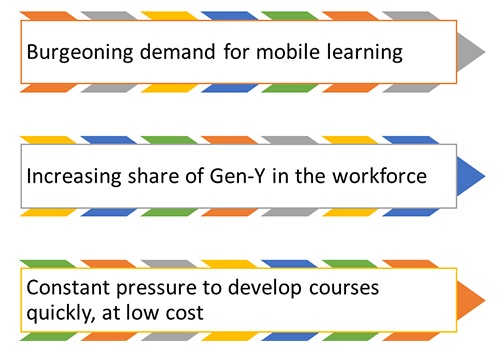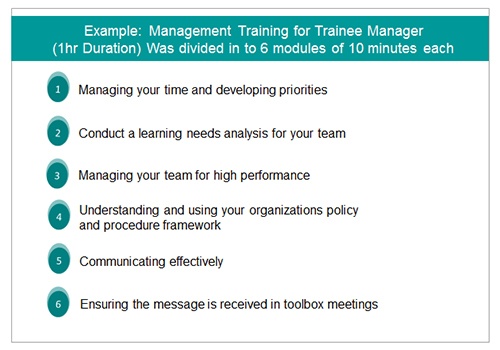What Is Bite Sized Learning?
Traditional eLearning courses usually are 30 minutes to 1 hour in duration. These courses are highly interactive in nature and were developed using Flash. The development time of these courses is usually between 3 and 6 months. The traditional method of eLearning development was used when there was no need for frequent updates of the course content. These courses were also designed for desktops and laptops. However, this traditional scenario has changed and given way to the development of new bite sized learning modules.
Bite sized learning is an eLearning paradigm that has taken the corporate training world by storm. In a recent survey conducted by the Rapid Learning Institute, 94% of Learning and Development professionals stated that bite sized online learning modules were preferred by their learners (Boyette, 2012). What makes bite sized learning immensely popular? How can these short eLearning courses help deliver training that is highly effective?
Well, before we examine the benefits of bite sized courses, let us look at the three important factors that have contributed to the phenomenal growth of bite sized learning.
3 Factors Contributing To The Growth Of Bite Sized Learning

- Burgeoning demand for mobile learning.
According to Ambient Insight, the global mobile learning market is likely to touch $12.2 billion by 2017, registering a staggering compound annual growth rate of 18.2% for the period 2012 to 2017 (Ambient Insight, 2013). The rapid growth of mobile learning has resulted in a huge increase in the number of firms using bite sized learning programs. Lessons delivered on mobile devices need to be concise and short for creating best learner experiences. This is because people often access learning content using their mobile phones while they are travelling and find it hard to focus on lengthy online modules. - Increasing share of Gen Y in the workforce.
Gen Y or Millennials are those who are born after 1980. According to PricewaterhouseCoopers (PwC), by 2020, Millennials are expected to constitute half of the global workforce (PwC, 2011). Various studies have shown that most learners belonging to Gen Y multitask and have short attention spans. Bite sized learning is perfectly suited to such people, and many firms are catering to this segment by delivering training content in the form of information nuggets. - Constant pressure to develop courses quickly and economically.
Training budgets are shrinking and the demands for quick rollout of online courses are on the rise. Many Learning and Development mangers are adopting bite sized courses to meet this need, as short eLearning modules can be developed much faster and in a cost-effective manner than lengthy online courses.
3 Benefits Of Bite Sized Learning
Let us now look at how bite sized learning can help deliver better training and enhance the performance of employees in an organization: 
- Bite sized learning results in better learner engagement.
This is arguably the biggest advantage of using learning nuggets to impart training. Learners often find it hard to focus on courses for more than 20 minutes at one stretch (Kelly, 2013). Also, it is common knowledge that once learner’s focus is lost, the purpose of the course is defeated. This issue can be effectively overcome with bite sized modules because of their short duration. - Learning nuggets can be digested effectively.
It is a well-known fact that humans have limited capacity to process information. Lynne Millward, in his book Understanding Occupational & Organizational Psychology, states that information is most likely to be meaningfully processed when it is presented in chunks (Millward, 2005). Bite sized courses are perfectly “tailored” to our brains, which are more effective in comprehending morsels of information compared to mountains of data. - Short learning modules help provide effective just-in-time (JIT) support.
Bite sized courses are the most effective means of delivering JIT support. For example, while repairing an SUV, an automobile mechanic can instantly get the needed information by accessing a bite sized course on the product, through an app installed on his smartphone.
Impact Of Bite Sized Learning On Online Course Design And Development
While bite sized courses help impart training of high quality and improve performance, they cannot be designed in a similar manner as that of traditional lengthy stand-alone eLearning courses. There are some modifications that we need to make when creating such bite sized eLearning courses or modules. Let’s see what these changes can be:
- Changes in presentation patterns of learning content.
Michael Kerres in his whitepaper Micro Learning As A Challenge For Instructional Design points out that most eLearning designers follow temporal dramaturgies while creating online courses (Kerres, 2007). For instance, a vast majority of “traditional” eLearning courses have a fixed structure with a beginning, description of the subject-matter, a few exercises, and an ending. Prof. Kerres states that these lesson dramaturgies are absent in bite sized learning modules; instead these short modules convey the information “directly.” - One learning objective is addressed by one bite sized module.
eLearning courses of longer duration (say 30 minutes and more) are often intended to achieve multiple learning objectives. But, micro learning facilitated by bite sized modules can be effective only when one learning objective is addressed in a single module, as these modules do not exceed 15 minutes. - More flexibility to deliver personalized learning.
When the learning content is divided into several bite sized modules, learners can access the parts of the content that are relevant to their work and skip the ones that they do not need. This makes learning more “individual”. For example, a finance professional may only opt for a module that explains the creation of a discounted cash flow model; he may not show interest in going through the modules that deal with other models. - eLearning developers can repurpose and reuse bite sized modules.
Related bite sized modules can be combined to create eLearning curricula. For instance, bite sized modules on various aspects of the Lean manufacturing process can be combined to create a comprehensive curriculum on the manufacturing process. Similarly, a bite sized module can be used in multiple online courses. For example, a short module explaining the basics of Sarbanes-Oxley (Sox) Act can be used in eLearning courses on compliance as well as accounting processes. - Growth in the use of videos.
The advent of bite sized learning has resulted in many eLearning designers using videos in online courses. Research shows that videos are ideal to convey the intended message very effectively in a short span of time (Eades, 2015). Furthermore, videos can be shot easily; we can create a video in a few seconds using the smartphone. Unlike earlier, with such advancements in the field of technology, a short video can be created easily without the need for sophisticated equipment or without depending on professional videographers.
We will now see how a few organizations have harnessed bite sized online courses to impart highly effective training.
Case Studies Of Successful Implementation Of Bite Sized Learning
Here are some examples of how some or the organizations are using bite sized learning for their employees:
- Harnessing the power of micro-blogging to deliver bite sized learning.
A leading multinational organization in the ICT sector utilizes the micro blogging platform Yammer to impart effective micro learning through bite sized learning units (Schone & Polaschek, 2009). The company uses Yammer very effectively to transmit short learning material from Subject Matter Experts and knowledge experts. The micro blogging service is also used to help personnel of various departments to collaborate efficiently. Staff members regularly share their experiences and exchange ideas through information nuggets. The effective use of bite sized modules has ensured effective flow of information and ensured that that all departments are on the same page. - Using bite sized modules to sell better.
A global pharmaceutical organization has leveraged the full potential of bite sized learning to enable its medical representatives sell drugs better. The company has developed a library of bite sized online modules and videos, which can be accessed by the representatives on their iPads anytime, anywhere. The sales personnel can go through the learning resources while travelling to prepare themselves to answer physicians’ queries better. Furthermore, these bite sized modules contributed in a major way to reduce the cognitive load on the learners. - Providing real-time information nuggets to enhance efficiency of distribution.
A reputed food products manufacturer uses information nuggets to inform drivers and merchandisers on the latest changes to product schedules, while on the move. The company provides these updates through a centralized tracking station, which can be accessed on the mobile devices of the staff. This is very useful to ensure that the products have been delivered to the right place, at the right time, in the right quantity.
The adoption of bite sized learning has received a fillip with the advent of mobile learning and increase in the number of Gen Y workers. It has transformed the way eLearning content is developed and used. Learning nuggets can be developed quickly, at low costs and go a long way in delivering highly effective learning and in improving the performance of workplace personnel. Undoubtedly, the future of eLearning is bite sized learning.
References:
- Ambient Insight. (2013). The 2012-2017 Worldwide Mobile Learning Market. WA, USA: Ambient Insight.
- Boyette, M. (2012, May 12). RLI survey: Bite-size learning is hot at ASTD Conference, but execution is lagging back on the home front
- Eades, J. (2015, June 6). Why Video Is The Best Medium For Microlearning
- Kelly, R. (2013, Jan 24). Brain-Based Online Learning Design
- Kerres, M. (2007). Microlearning as a challenge for Instructional Design. In T. &. Hug, Didactics of microlearning: Concepts, discourses, and examples (pp. 98-109). Muenster: Waxmann
- Millward, L. (2005). Understanding Occupatonal & Organizational Psychology. UK: Sage.
- PwC. (2011). Millennials at work - Reshaping the workplace. New York: PricewaterhouseCoopers
- Schone, B. J., & Polaschek, J. (2009, Nov 11). A Case Study of Micro-Blogging for Learning at Qualcomm











